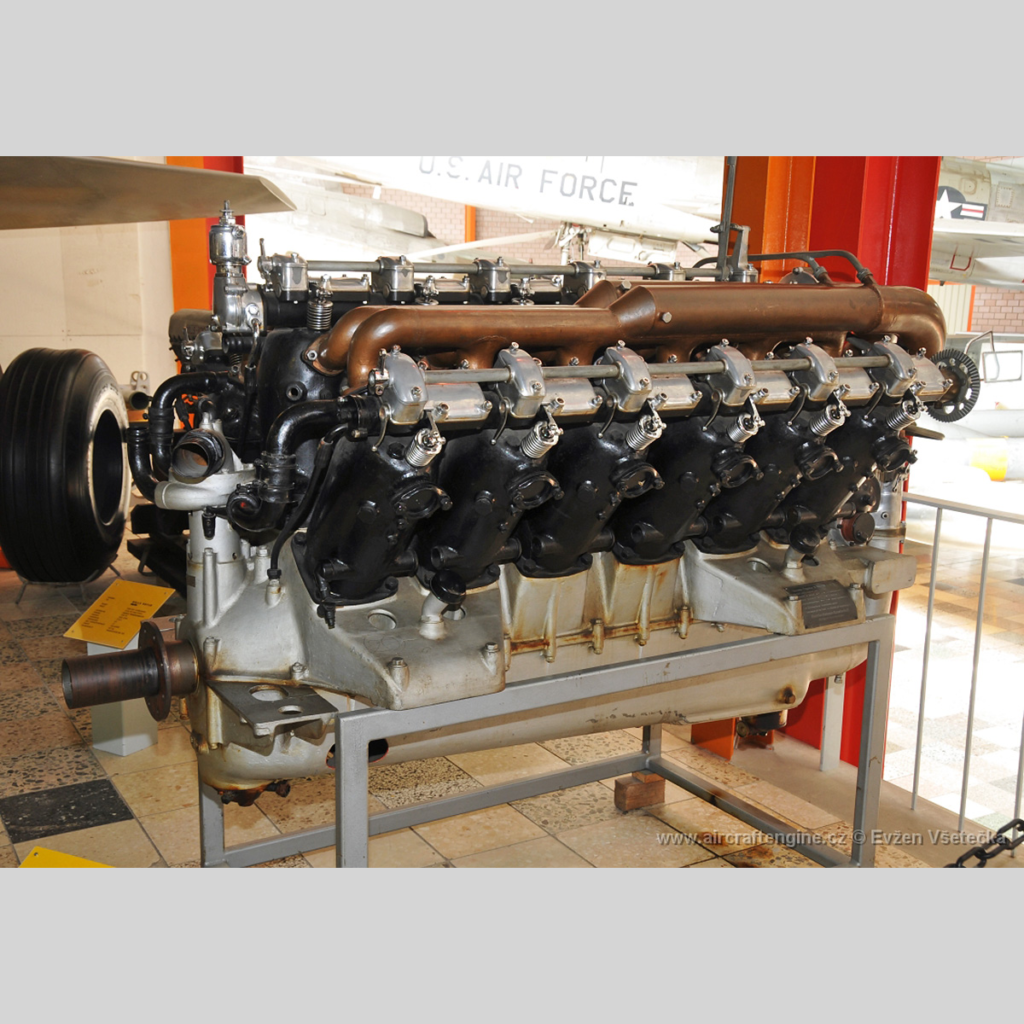
By 1915, the Germans had begun to experiment with very large aircraft known as Riesenflugzeug (giant aircraft). These aircraft had been developed from the G-class bombers and are often referred to as R-planes. In 1916, the potential of such an aircraft to carry heavy bombloads into enemy territory was recognized, and the deficiencies of airships that had been developed to serve in that same role was apparent. Efforts were undertaken to increase R-plane production and withdraw airships from long-range bomber missions.

The preserved Daimler-Mercedes D VI W-18 engine. The individual cylinders on each bank were linked by a common overhead camshaft housing. Note the water-jacketed copper intake manifolds. (Evžen Všetečka image via www.aircraftengine.cz)
To promote the development of larger and more capable R-planes, larger and more powerful aircraft engines were needed. As early as 1915, the Idflieg (Inspektion der Fliegertruppen or Inspectorate of Flying Troops) had encouraged various German engine manufacturers to develop large aircraft engines capable of 500 hp (375 kW). These engines were known as Class VI engines and would be used to power R-planes. Daimler Motoren Gesellschaft (Daimler) was one of the companies that worked to build a large Class VI aircraft engine.
Daimler’s design was known as the D VI, but it is also referred to as the Mercedes D VI or Daimler-Mercedes D VI. Daimler often used the Mercedes name for many of its products. The D VI engine utilized the basic cylinder from the 180 hp (134 kW) Daimler-Mercedes D IIIa engine and incorporated features from the 260 hp (194 kW) D IVa engine. Both of those engines were six-cylinder inlines. However, the D VI had three rows of six-cylinders, creating a W-18 engine. The center cylinder row was vertical, and the left and right rows were angled 40 degrees from the center row.

Front view of the D VI illustrates the water pump mounted directly in front of the center cylinder bank. Note the direct drive crankshaft. (Evžen Všetečka image via www.aircraftengine.cz)
The D VI engine used individual steel cylinders with one intake and one exhaust valve. The valves of each cylinder row were actuated by a single overhead camshaft driven from the rear of the engine via a vertical shaft. The camshaft acted upon rocker arms that protruded from the camshaft housing above each cylinder to the exposed cylinder valves. A water jacket made of pressed steel was welded to the cylinder. Each piston was made of a forged-steel head screwed and welded onto a cast iron skirt. The cylinder’s compression ratio was 4.7 to 1.
Each cylinder was attached to the two-piece steel crankcase via four studs. Most likely, the studs for the center cylinder row extended into the bottom half of the crankcase and helped secure the two crankcase halves. The crankshaft was supported by seven main bearings and was connected directly to the propeller. A water pump was driven by the crankshaft at the front of the engine. At the rear of the engine, a vertical shaft extending from the crankshaft drove a magneto for each cylinder bank and an oil pump. Each of the cylinders had two spark plugs.
Induction air was drawn into an air chamber inside the crankcase where it was warmed. The air then passed through two water-jacketed pipes cast integral with the lower crankcase half at the rear of the engine. The two pipes split into three inline carburetors, each feeding one cylinder bank via an intake manifold. The intake manifold was made of copper and was water-jacketed. The left cylinder bank had its intake manifold positioned on the right side. The center and right cylinder banks had their intake manifolds positioned on the left side. The exhaust was expelled from each cylinder via an individual stack on the side opposite the intake.

Rear view of the D VI shows the engine’s induction stemming from the lower crankcase housing and feeding into the three carburetors.
The D VI had a 5.51 in (140 mm) bore and a 6.30 in (160 mm) stroke. The engine’s total displacement was 2,705 cu in (44.3 L). The D VI produced 513 hp (382 kW) at 1,440 rpm for takeoff and had a maximum continuous output of 493 hp (368 kW) at 1,400 rpm. Specific fuel consumption was .477 lb/hp/hr (290 g/kW/h). The engine weighed 1,636 lb (742 kg).
The Daimler D VI engine was first run in 1916. However, development of the D IIIa and D IVa engines took priority, causing the D VI to lag behind. The D VI passed a certification test in December 1918, but World War I was over by that time, and such and engine was no longer needed. Military restrictions imposed on Germany by the Treaty of Versailles most likely influenced the abandonment of the D VI engine, and no further work was undertaken.
The sole surviving D VI engine has been preserved and is on display at the Flugausstellung L.+ P. Junior museum in Hermeskeil, Germany.

The D VI engine had mounts cast integral with the upper crankcase, but the engine was never installed in any aircraft. Note the pedestal pads onto which the cylinders were mounted. (Evžen Všetečka image via www.aircraftengine.cz)